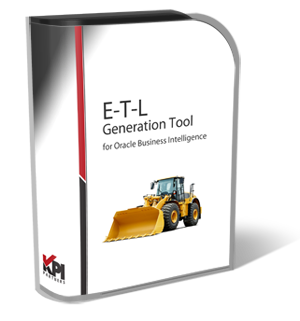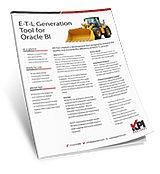E-T-L Generation Tool for Oracle BI
KPI has created a development tool designed to enhance the quality and increase the efficiency of the E-T-L process
What is E-T-L?
E-T-L is an acronym for extract, transform, and load. These are three database functions that are combined into one process to pull data out of one data source and place it into another data source. In the world of business intelligence, E-T-L is primarily used to migrate data from data sources to a data warehouse.
Extract is the process of reading data from a database. Transform is the process of converting the extracted data into a usable form based on defined rules to clean, scrub, combine, reformat, and recalculate. Load is the process of writing the data into the target data source.
Overview
KPI Partners has developed a solution that automates the ETL process for customizations to standard, out-of-the-box, Oracle BI Applications functionality. KPI’s E-T-L Generation Tool for Oracle BI includes E-T-L customization templates and a framework to generate customized Informatica E-T-L.
The ETL customization templates provide the ability to design customized source-to-target mappings that drive the automation framework.
Business Benefit
KPI’s E-T-L Generation Tool for Oracle BI can decrease development cost and development time up to 30% with increased quality.
Integration & Compliance
The E-T-L Generation Tool for Oracle BI is a natural extension of KPI’s Implementation Methodology for Oracle BI Applications. The tool is fully integrated with Oracle BI and is compliant with standards for Oracle ETL.
Common Customization Scenarios
In nearly every deployment of Oracle BI Applications, an organization must modify the out-of-the-box application to suit their business needs. The following are common customizations to Oracle BI Applications where KPI’s E-T-L Generation Tool for Oracle BI will enhance quality and increase efficiency:
- Reporting on new ERP data sources
- Addition of new columns to existing dimensionsModifying keys in out-of-the-box fact tables
- Addition of new fact tables
- Addition of new snapshot tables
- Addition of new tables for performance tuning
- Slowly changing dimension logic for dimensions
- Addition of new columns to existing facts, snapshots and aggregates
.









